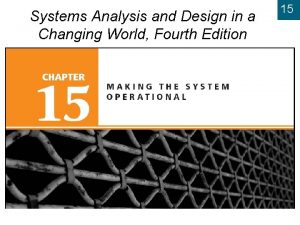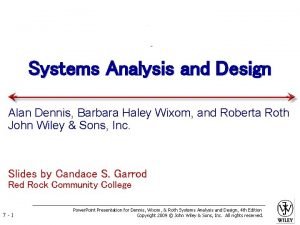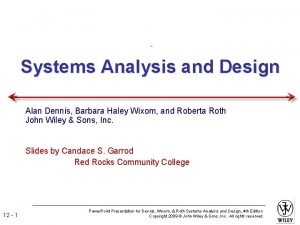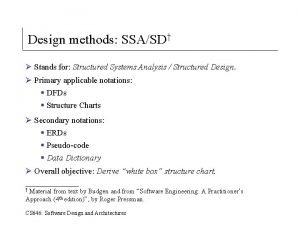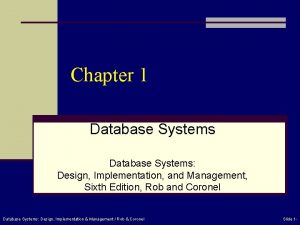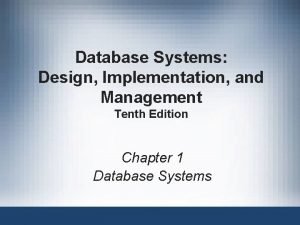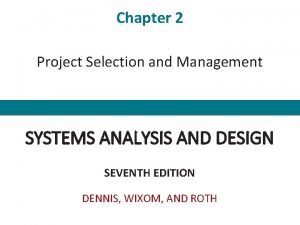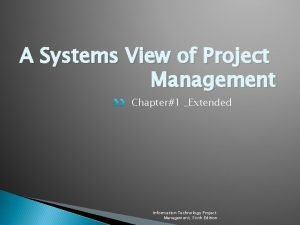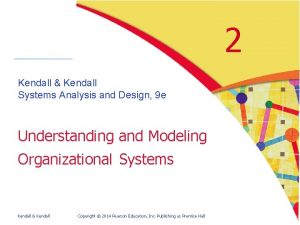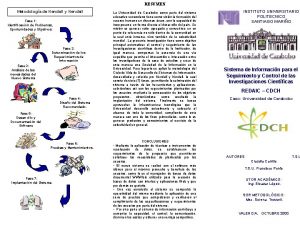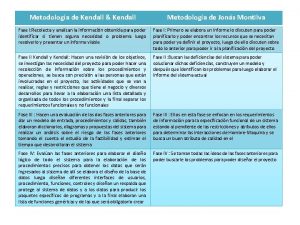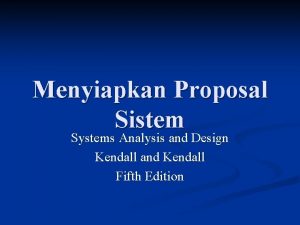Project Management Systems Analysis and Design Kendall Kendall




















































- Slides: 52

Project Management Systems Analysis and Design, Kendall & Kendall © 2008 Pearson Prentice Hall 3

Learning Objectives • Understand how projects are initiated and selected • Define a business problem and determine the feasibility of a proposed project • Plan a project by identifying activities and scheduling them • Manage team members and analysis and design activities so the project objectives are met while the project remains on schedule Kendall & Kendall 3 -2

Project Management Fundamentals • Initiating Project • Determining project feasibility • Ascertaining Hardware and Software Needs • Activity planning and control • Project scheduling • Managing systems analysis team members Kendall & Kendall 3 -3

Initiating Project • Problems in the organization • Problems that lead themselves to systems solutions • Opportunities for improvement • Caused through upgrading, altering, or installing new systems Kendall & Kendall 3 -4

Figure 3. 1 Checking output, observing employee behavior, and listening to feedback are all ways to help the analyst pinpoint systems problems and opportunities Kendall & Kendall 3 -5

Problem Definition • Problem statement • Paragraph or two stating the problem or opportunity • Issues • Independent pieces pertaining to the problem or opportunity • Objectives • Goals that match the issues point-by-point • Requirements • The things that must be accomplished along with the possible solutions, and constraints, that limit the development of the system Kendall & Kendall 3 -6

Problem Definition Steps • Find a number of points that may be included in one issue • State the objective • Determine the relative importance of the issues or objectives • Identify which objectives are most critical Kendall & Kendall 3 -7

Example: Catherine’s Catering • Catherine’s Catering is a small business that caters meals, receptions, and banquets for business and social occasions such as birthdays, weddings etc. • At first it was a small company. Catherine talked to the customers to determine the number of people, the type of meals, and other information necessary to cater an event. • Catherine was able to manage the business using spreadsheets and word processing but found difficulty in keeping up with endless phone calls about what types of meals were available, changes to the number of guests attending the event, scheduling part time employees etc. Kendall & Kendall 3 -8

Kendall & Kendall 3 -9

Selection Of Projects • Backing from management • Appropriate timing of project commitment • Possibility of improving attainment of organizational goals • Practical in terms of resources for the system analyst and organization • Worthwhile project compared with other ways the organization could invest resources Kendall & Kendall 3 -10

Determining Feasibility • Defining objectives • Determining resources • Operationally • Technically • Economically Kendall & Kendall 3 -11

Defining Objectives Many possible objectives exist including: • • Kendall & Kendall Speeding up a process Streamlining a process Combining processes Reducing errors in input Reducing redundant storage Reducing redundant output Improving system and subsystem integration 3 -12

Figure 3. 5 The three key elements of feasibility include technical, economic, and operational feasibility Kendall & Kendall 3 -13

Technical Feasibility • Can current technical resources be upgraded or added to in a manner that fulfills the request under consideration • If not, is there technology in existence that meets the specifications Kendall & Kendall 3 -14

Economic Feasibility • Economic feasibility determines whether value of the investment exceeds the time and cost • Includes: • • • Kendall & Kendall Analyst and analyst team time Business employee time Hardware Software development 3 -15

Operational Feasibility • Operational feasibility determines if the human resources are available to operate the system once it has been installed • Users that do not want a new system may prevent it from becoming operationally feasible Kendall & Kendall 3 -16

Ascertaining Hardware and Software Needs Steps used to determine hardware and software needs: • Inventory computer hardware currently available • Estimate current and future system workloads • Evaluate available hardware and software • Choose the vendor • Acquire the computer equipment Kendall & Kendall 10 -17

Figure 10. 1 Steps in choosing hardware and software Kendall & Kendall 10 -18

Inventorying Computer Hardware • • • Type of equipment Operation status of the equipment Estimated age of equipment Projected life of equipment Physical location of equipment Department or person responsible for equipment • Financial arrangement for equipment Kendall & Kendall 10 -19

Estimating Workloads • Systems analysts formulate numbers that represent both current and projected workloads for the system so that any hardware obtained will possess the capability to handle current and future workloads Kendall & Kendall 10 -20

Figure 10. 2 Comparisons of workloads between existing and proposed systems Kendall & Kendall 10 -21

Evaluating Hardware • • Time required for average transactions Total volume capacity of the system Idle time of the CPU or network Size of memory provided Kendall & Kendall 10 -22

People That Evaluate Hardware • Management • Users • Systems analysts Kendall & Kendall 10 -23

Acquisition of Computer Equipment • Buying • Leasing • Rental Kendall & Kendall 10 -24

Buying Kendall & Kendall 10 -25

Leasing Kendall & Kendall 10 -26

Renting Kendall & Kendall 10 -27

Software Alternatives • Created custom software • Purchased as COTS (commercial off-theshelf) software • Provided by an application service provider (ASP) Kendall & Kendall 10 -28

Creating Custom Software Kendall & Kendall 10 -29

Purchasing COTS Packages MS Word, Excel, Access, Antivirus and numerous other software that you can buy and use. Kendall & Kendall 10 -30

Using An ASP Examples: Gmail, Yahoo mail, Google Doc, Google spreadsheet, Google Service interfaces like calendar, Hotmail, Online tools and services. Kendall & Kendall 10 -31

Software Evaluation • • • Performance effectiveness Performance efficiency Ease of use Flexibility Quality of documentation Manufacturer support Kendall & Kendall 10 -32

Figure 10. 7 Guidelines for evaluating software Kendall & Kendall 10 -33

Identifying Benefits and Costs • Tangible • Intangible Kendall & Kendall 10 -34

Tangible Benefits • Advantages measurable in dollars that accrue to the organization through the use of the information system • Examples: • • Increase in the speed of processing Access to otherwise inaccessible information Access to information on a more timely basis The advantage of the computer’s superior calculating power • Decreases in the amount of employee time needed to complete specific tasks Kendall & Kendall 10 -35

Intangible Benefits • Intangible benefits are benefits from use of the information system that are difficult to measure • Examples: • • Kendall & Kendall Improving the decision-making process Becoming more competitive in customer service Maintaining a good business image Increasing job satisfaction 10 -36

Tangible Costs • Those that can be accurately projected by systems analysts and the business’ accounting personnel • Examples: • • • Kendall & Kendall Cost of equipment Cost of resources Cost of systems analysts' time Cost of programmers’ time Employees’ salaries 10 -37

Intangible Costs • Those that are difficult to estimate, and may not be known • Examples: • • Kendall & Kendall Losing a competitive edge Losing the reputation Declining company image Ineffective decision making 10 -38

Comparing Costs and Benefits • • Break-even analysis Payback Cash-flow analysis Present value analysis Kendall & Kendall 10 -39

Break-Even Analysis • The point at which the total cost of the current system and the proposed system intersect • Useful when a business is growing and volume is a key variable in costs • Disadvantage • Benefits are assumed to remain the same • Advantage • Can determine how long it will take for the benefits of the system to pay back the costs of developing it Kendall & Kendall 10 -40

Figure 10. 13 Break-even analysis showing a payback period of three and a half years Kendall & Kendall 10 -41

Activity Planning And Control • Planning includes: • Selecting a systems analysis team • Estimating time required to complete each task • Scheduling the project • Control includes: • Comparing the plan for the project with its actual evolution • Taking appropriate action to expedite or reschedule activities Kendall & Kendall 3 -42

Estimating Time • Project is broken down into phases • Further project is broken down into tasks or activities • Finally project is broken down into steps or even smaller units • Time is estimated for each task or activity • Most likely, pessimistic, and optimistic estimates for time may be used Kendall & Kendall 3 -43

Figure 3. 6 Beginning to plan a project by breaking it into three major activities Kendall & Kendall 3 -44

Figure 3. 7 Refining the planning and scheduling of analysis activities by adding detailed tasks and establishing the time required to complete the tasks Kendall & Kendall 3 -45

Project Scheduling • Gantt Charts • Simple • Lends itself to end user communication • Drawn to scale • PERT diagrams • Useful when activities can be done in parallel Kendall & Kendall 3 -46

Figure 3. 8 Using a two-dimensional Gantt chart for planning activities that can be accomplished in parallel Kendall & Kendall 3 -47

PERT Diagram Kendall & Kendall 3 -48

Figure 3. 12 A completed PERT diagram for the analysis phase of a systems project Kendall & Kendall 3 -49

PERT Diagram Advantages • Easy identification of the order of precedence • Easy identification of the critical path and thus critical activities Kendall & Kendall 3 -50

Project Failures • Project failures may be prevented by: • Training • Experience • Learning why other projects have failed • Project charter • Describes in a written document what the expected results of the systems project are and the time frame for delivery Kendall & Kendall 3 -51

Kendall & Kendall 3 -52
 Determining human information requirements
Determining human information requirements Kendall & kendall systems analysis and design
Kendall & kendall systems analysis and design Patched up prototype
Patched up prototype System analysis and design kendall
System analysis and design kendall System analysis and design kendall
System analysis and design kendall System analysis and design kendall
System analysis and design kendall Project management in system analysis and design
Project management in system analysis and design It analysis design and project management
It analysis design and project management Importance of software project management
Importance of software project management Systems analysis and design in an age of options
Systems analysis and design in an age of options Systems analysis and design in a changing world
Systems analysis and design in a changing world Systems analysis and design in a changing world
Systems analysis and design in a changing world System analysis and design in a changing world
System analysis and design in a changing world System analysis and design alan dennis
System analysis and design alan dennis Introduction to systems analysis and design
Introduction to systems analysis and design Major tools of ssadm
Major tools of ssadm Modern system analysis and design
Modern system analysis and design Modern systems analysis and design
Modern systems analysis and design System analysis and design dennis
System analysis and design dennis Systems analysis and design alan dennis
Systems analysis and design alan dennis Systems analysis and design alan dennis
Systems analysis and design alan dennis Systems analysis and design alan dennis
Systems analysis and design alan dennis Systems analysis and design alan dennis
Systems analysis and design alan dennis Systems analysis and design alan dennis
Systems analysis and design alan dennis Systems analysis and design alan dennis
Systems analysis and design alan dennis Structured systems analysis and design method
Structured systems analysis and design method Radar range equation snr
Radar range equation snr Object-oriented systems analysis and design using uml
Object-oriented systems analysis and design using uml A modern approach to systems analysis and design
A modern approach to systems analysis and design Systems analysis and design in a changing world
Systems analysis and design in a changing world Systems analysis and design in a changing world
Systems analysis and design in a changing world Systems analysis and design in a changing world
Systems analysis and design in a changing world Systems analysis and design alan dennis
Systems analysis and design alan dennis Systems analysis and design alan dennis
Systems analysis and design alan dennis Systems analysis and design alan dennis
Systems analysis and design alan dennis Modern systems analysis and design 7th edition
Modern systems analysis and design 7th edition Ssadm
Ssadm Essentials of systems analysis and design
Essentials of systems analysis and design Systems analysis and design in a changing world
Systems analysis and design in a changing world Systems analysis and design alan dennis
Systems analysis and design alan dennis List the five basic steps of ssa/sd process
List the five basic steps of ssa/sd process System analysis and design in a changing world
System analysis and design in a changing world Systems analysis and design in a changing world
Systems analysis and design in a changing world Radar system analysis and design using matlab
Radar system analysis and design using matlab What is input/output design
What is input/output design Database system design implementation and management
Database system design implementation and management Database system design implementation and management
Database system design implementation and management Connecting rod 2d diagram
Connecting rod 2d diagram Project selection in system analysis and design
Project selection in system analysis and design Feasibility
Feasibility Three sphere model for project management
Three sphere model for project management Earned value ms project
Earned value ms project Security analysis and portfolio management project
Security analysis and portfolio management project





























